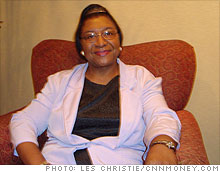Well, this technology, if eventually accepted, will quickly revert to using overseas physicians.
And this is the beginning of the end for American physicians just as using overseas workers was the beginning of the end for high tech jobs here.
Congress is now taking over the national health-care system and they are looking to slash high costs and wastes and programs like this claim to decrease costs. It will be embraced by the national health care provider.
Doctor's earning power will decrease significantly over time time and job openings dwindle just as it has for information technology workers.
How much of doctor visits concern mundane things like sniffles and fever? A great deal.
Add doctors to the list of professions you don't want your children to pursue.
Will anyone in the US profit from this? The large firms that provide this service will make a bundle.
Another indication that soon all jobs that can be done overseas WILL be done overseas.
The Virtual Visit May Expand Access to Doctors
SAN FRANCISCO — Americans could soon be able to see a doctor without getting out of bed, in a modern-day version of the house call that takes place over the Web.
OptumHealth, a division of UnitedHealth Group, the nation’s largest health insurer, plans to offer NowClinic, a service that connects patients and doctors using video chat, nationwide next year. It is introducing it state by state, starting with Texas, but not without resistance from state medical associations.
OptumHealth believes NowClinic will improve health care by ameliorating some of the stresses on the system today, like wasted time dealing with appointments and insurance claims, a shortage of primary care physicians and limited access to care for many patients.
But some doctors worry that the quality of care that patients receive will suffer if physicians neglect one of the most basic elements of health care: a physical exam.
“This is a pale imitation of a doctor visit,” said David Himmelstein, a primary care doctor and associate professor at Harvard Medical School. “It’s basically saying, ‘We’re going to give up any pretense of examining the patient and most of the nonverbal clues that doctors use.’ ”
Others, including Rashid Bashshur, director of telemedicine at the University of Michigan Health System, say online medicine is a less expensive way of providing routine care.
“The argument that you need the ‘laying on of hands’ to practice medicine is an old and tired argument that simply has no credibility,” he said. “There are two constants in medicine: change and resistance to change.”
Christopher Crow, a family physician in Plano, Tex., who used the system during its test period, said, “NowClinic gives you the ability to have that gut feel if something is wrong, in tone or facial expression or body language, that you have when you walk in the door with a patient.”
Many patients who do not have primary care physicians nearby use the emergency room for routine problems. Wait times for patients needing immediate attention have increased 40 percent, in part because of overcrowding, according to a study by Harvard Medical School and Cambridge Health Alliance.
In Texas, 180 counties do not have enough physicians, 70 percent of patients cannot obtain a same-day visit with their primary care doctor, and 79 percent of emergency room visits are for routine problems, according to OptumHealth.
“We are, through this technology, replenishing the pool of physicians and making them available to patients,” said Roy Schoenberg, chief executive of American Well, which created the system that OptumHealth is using.
For $45, anyone in Texas can use NowClinic, whether or not they are insured, by visiting NowClinic.com. Doctors hold 10-minute appointments and can file prescriptions, except for controlled substances. Eventually they will be able to view patients’ medical histories if they are available.
The introduction of NowClinic will be the first time that online care has been available nationwide, regardless of insurance coverage.
American Well’s service is also available to patients in Hawaii and Minnesota, through Blue Cross Blue Shield, and to some members of the military seeking mental health care, through TriWest Healthcare Alliance.
Some hospitals and technology companies provide similar services on a smaller scale, including Cisco, the networking equipment maker, which uses its videoconferencing technology to remotely connect employees with doctors. It is working with UnitedHealth Group to offer the service more broadly.
The service has encountered resistance in states where it is already available. Texas law requires that before doctors consult with patients or prescribe medicine online or over the phone, they form a relationship through means like a physical examination.
The Texas Medical Board, which regulates doctors in the state, is evaluating its telemedicine policies in light of new technologies. But Mari Robinson, executive director of the board, said that an online or telephone exam was inadequate if doctors and patients had not met in person and was “not allowed under our rules.”
After American Well’s service began in Hawaii last year, lawmakers passed legislation that allowed doctors and patients to establish a relationship online, though the Hawaii Medical Association opposed the bill.
“From our perspective, we still are a little bit concerned that a relationship can be established online with no prior relationship,” said April Troutman Donahue, the association’s executive director.
American Well and OptumHealth predict that health care professionals will adapt. “This is new technology, so you have a lot of code written that doesn’t take these medical technologies into account,” said Rob Webb, chief executive of OptumHealth Care Solutions.
Many patients seem ready to embrace the new technology. In a recent study, a Harvard research team at Beth Israel Deaconess Medical Center found that patients were comfortable with computers playing a central role in their health care and expected that the Web would substitute for face-to-face doctor visits for routine health problems.
